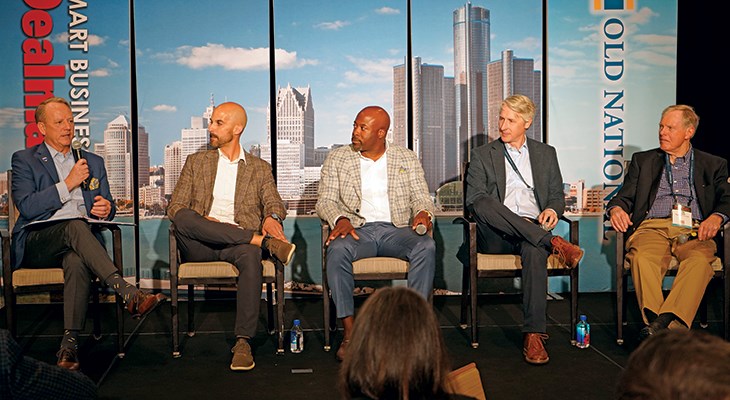During the midday panel at this year's Detroit Smart Business Dealmakers Conference, Old National Bank President Rick Hampson opened the discussion talking about the lifecycle of a business. Specifically, he asked the panelists how to assess the right time to make an investment — whether the decision is to sell or grow.
For ELab Ventures Managing Partner Paul Brown, whether or not to pursue growth hinges on the team in place. To that end, he says CEOs and owners must be brutally honest about they and their team's skill set before courting an investment.
"Different stages require vastly different skill sets," Brown says. "And as an early-stage investor, we're often very involved in the company when there may be a leadership transition from engineer founders, to experienced CEOs. And so, when deciding to invest or grow, I think the first question is, do you have the right people in their capabilities to grow into that next stage? I think you always should look to grow. But if the answer to that first question is no, then you have to look to augment the team. But I think that's the most important consideration. You've got to be brutally honest with yourself if you or your team has the right capabilities for that next phase."
From a family business perspective, Larry Brinker, Jr., president and CEO of Brinker, says the first thing for him was to create a culture where people believed and bought in. That, he says, can be incredibly difficult being the second-generation leader following the first generation. For the incoming leader, it means not only proving that he was capable of the task at hand, but also he had to make sure that he got the staff that's been there since the first gen to buy in, all while building his own team.
"And so, it's all about the people. It's all about creating the right culture and building that team that has similar values while still maintaining diversity of thought and leadership," Brinker says. "But it always comes down to the actual people, and it's no different with the family business investing in other companies. The most important thing is really the people. And it's how the people will interact with your people, your culture and your values."
For Plymouth Growth Founder and Senior Advisor Ian Bund, whether to invest starts with an assessment of the people in the business — can they be trusted, do they have a mind to build a business, high integrity and can be a partner as the business grows? And if, after an assessment, there's a decision to grow, choosing a growth partner to help with that growth requires a few considerations. For example, he says most firms have one or more specialties — like a focus on software or manufacturing companies. They have a well-defined target range for annual recurring revenues as well as a certain liquidity horizon — often three to five years, but sometimes longer. So, it's important to find one that fits the business.
When it comes to finding the right people to feel confident making an investment in the business, Author and Leadership Coach Mark Ostach says part of the recruitment process is giving prospects a glimpse of the culture. That's done, he says, both by the person recruiting that individual and the way they're engage for a tour.
"It's like going to a college campus; they send you with the ambassadors of the school to tour the school. And they do that intentionally because that person who's the ambassador has a heart for the school — the vision, the values and the impact the school has had. So, find those ambassadors in your internal organization, even if they're not in recruiting, and make sure they're helping to showcase your values and your organization in the recruitment process."




